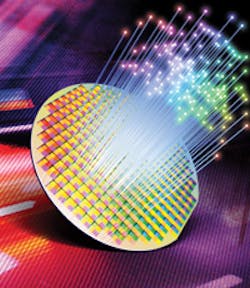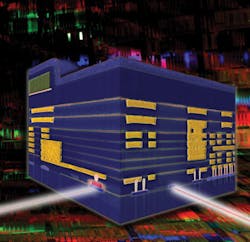Is silicon photonics all it's cracked up to be? And if you aren't working on it, are you doomed?
After several years of talking about silicon photonics – the use of CMOS technology to create integrated optical devices rather than the more exotic materials commonly in use – Intel Corp. announced in mid-January at the Open Compute Summit in Santa Clara, CA, that it had delivered engineering samples of 100-Gbps silicon photonics technology for a new rack architecture it had created with Facebook. The news, taken alongside the work done by other vendors and what little is known about Cisco's silicon photonics-based CPAK module effort, led Jefferies & Co. analyst James Kisner to downgrade Finisar's common shares to "underperform" and cut his target price by nearly 50%. Finisar's shares tumbled 10% in the immediate aftermath.
The imminent arrival of modules based on silicon photonics was a harbinger of big trouble for Finisar and other traditional transceiver vendors, Kisner reasoned. "While we suspect it will be a while before we see optical transceivers from Intel, our checks suggest a number of players, including Cisco, are likely to launch silicon photonics-based transceivers for 100G applications in the data center in 2013 and 2014," he wrote.
But not everyone bought Kisner's thesis. Another financial analysis firm, Needham & Co., called the threat of silicon photonics to Finisar "overblown." Intel's technology is limited in reach and Cisco's CPAK modules won't be distinctly different than CFP2 modules, according to the firm.
So just how disruptive should we expect silicon photonics to be – both in terms of performance and economics, as well as creating a watershed moment for the optical-transceiver market?
Silicon photonics' promise
Silicon photonics' benefits mirror those of photonic integrated circuits (PICs). They include the ability to create highly integrated, multifunctional components on wafers. The bonus silicon photonics promises is the use of CMOS, a much more economical process than the indium phosphide common to PICs and other optical components. The use of CMOS also creates the opportunity to accommodate optical and electrical signals in the same device.
Intel and IBM were the first big name companies to throw their R&D weight behind silicon photonics and keep it there. Intel appears closer to a product than IBM, but IBM reported last December that it had verified its "silicon nanophotonics" technology in a manufacturing environment. The resulting device combines modulators, germanium photodetectors, and multiplexers as well as electronic circuits (see Figure) and uses 90-nm CMOS technology. (Unlike Intel, IBM hasn't created a silicon-based light emitter.) The devices support data rates of more than 25 Gbps. IBM shares Intel's focus on data-center and high-performance computing applications.
While these two heavyweights stole most of the silicon photonics headlines early on, other companies more quietly brought silicon-based optical products to market. For example, Luxtera created a transceiver that formed the heart of its Blazar active optical cable line, which it later sold to Molex. Almost immediately after the sale, Luxtera unveiled its LUX2020A optical engine, aimed at the same applications as Intel's and IBM's technologies.
Meanwhile, Kotura followed suit at OFC/NFOEC last year with its 4×25-Gbps optical engine. The two-chip device is distinctive for the incorporation of WDM functionality, along the lines of Intel and IBM.
A company that has received even more attention recently is Lightwire – not for producing a revolutionary product but for being acquired by Cisco. The systems house will use Lightwire's silicon photonics intellectual property in its CPAK transceiver. And it's this silicon photonics effort that may influence the optical communications market most significantly.
(Perceived) perils of silicon photonics
There likely will be more products taking advantage of silicon photonics in the reasonably near term. But just looking at what's available now, Cisco's CPAK will have the most impact on the optical communications industry.
As technologically sexy as the Intel and IBM efforts appear, they're targeted at an application in which optical communications has made little headway. Intra-rack, and even short reach inter-rack, communications remains overwhelmingly a copper-dominated application. So even if the Intel and IBM efforts succeed, they're likely to do no more than limit new opportunities for traditional players rather than displace them from existing applications. And before those efforts achieve success, Intel and IBM have to create commercial products, have those products adopted (potentially with a lack of second sources, unless Luxtera, Kotura, or some startup falls in line), then successfully mass produce them.
Cisco's CPAK likely will reach directly into the wallets of mainstream transceiver vendors if for no other reason than Cisco is a major customer for many of these companies. Any time a customer decides to build your product in-house, that's bad news.
Silicon photonics is still in its infancy. It may indeed change the course of the optical communications market, but not before it grows up first.
STEPHEN HARDY is editorial director and associate publisher ofLightwave.
Past Lightwave Issues
About the Author
Stephen Hardy
Editorial Director and Associate Publisher
Stephen Hardy has covered fiber optics for more than 15 years, and communications and technology for more than 30 years. He is responsible for establishing and executing Lightwave's editorial strategy across its digital magazine, website, newsletters, research and other information products. He has won multiple awards for his writing.
Contact Stephen to discuss:
- Contributing editorial material to the Web site or digital magazine
- The direction of a digital magazine issue, staff-written article, or event
- Lightwave editorial attendance at industry events
- Arranging a visit to Lightwave's offices
- Coverage of announcements
- General questions of an editorial nature


